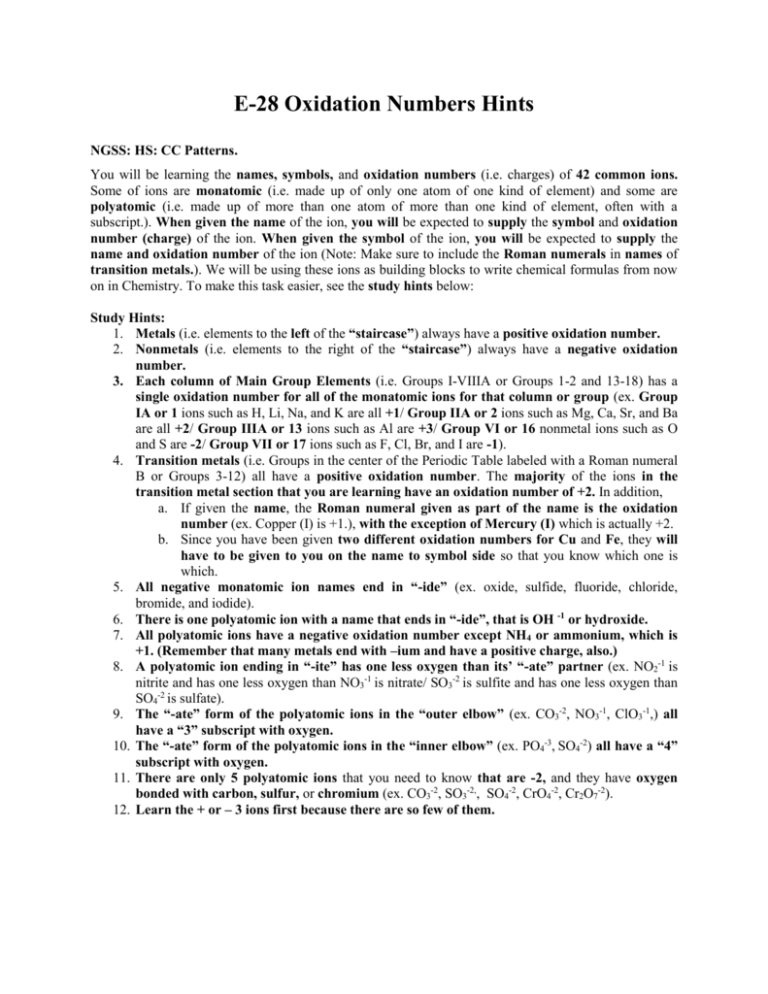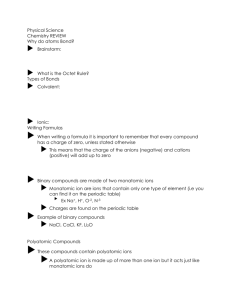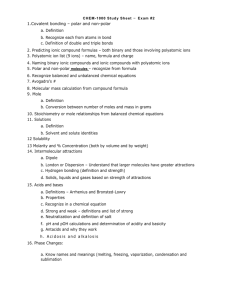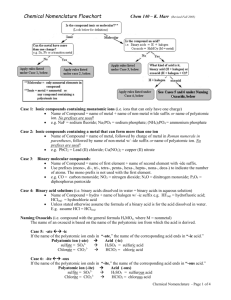E-28 Oxidation Numbers Hints
advertisement

E-28 Oxidation Numbers Hints NGSS: HS: CC Patterns. You will be learning the names, symbols, and oxidation numbers (i.e. charges) of 42 common ions. Some of ions are monatomic (i.e. made up of only one atom of one kind of element) and some are polyatomic (i.e. made up of more than one atom of more than one kind of element, often with a subscript.). When given the name of the ion, you will be expected to supply the symbol and oxidation number (charge) of the ion. When given the symbol of the ion, you will be expected to supply the name and oxidation number of the ion (Note: Make sure to include the Roman numerals in names of transition metals.). We will be using these ions as building blocks to write chemical formulas from now on in Chemistry. To make this task easier, see the study hints below: Study Hints: 1. Metals (i.e. elements to the left of the “staircase”) always have a positive oxidation number. 2. Nonmetals (i.e. elements to the right of the “staircase”) always have a negative oxidation number. 3. Each column of Main Group Elements (i.e. Groups I-VIIIA or Groups 1-2 and 13-18) has a single oxidation number for all of the monatomic ions for that column or group (ex. Group IA or 1 ions such as H, Li, Na, and K are all +1/ Group IIA or 2 ions such as Mg, Ca, Sr, and Ba are all +2/ Group IIIA or 13 ions such as Al are +3/ Group VI or 16 nonmetal ions such as O and S are -2/ Group VII or 17 ions such as F, Cl, Br, and I are -1). 4. Transition metals (i.e. Groups in the center of the Periodic Table labeled with a Roman numeral B or Groups 3-12) all have a positive oxidation number. The majority of the ions in the transition metal section that you are learning have an oxidation number of +2. In addition, a. If given the name, the Roman numeral given as part of the name is the oxidation number (ex. Copper (I) is +1.), with the exception of Mercury (I) which is actually +2. b. Since you have been given two different oxidation numbers for Cu and Fe, they will have to be given to you on the name to symbol side so that you know which one is which. 5. All negative monatomic ion names end in “-ide” (ex. oxide, sulfide, fluoride, chloride, bromide, and iodide). 6. There is one polyatomic ion with a name that ends in “-ide”, that is OH -1 or hydroxide. 7. All polyatomic ions have a negative oxidation number except NH4 or ammonium, which is +1. (Remember that many metals end with –ium and have a positive charge, also.) 8. A polyatomic ion ending in “-ite” has one less oxygen than its’ “-ate” partner (ex. NO2-1 is nitrite and has one less oxygen than NO3-1 is nitrate/ SO3-2 is sulfite and has one less oxygen than SO4-2 is sulfate). 9. The “-ate” form of the polyatomic ions in the “outer elbow” (ex. CO3-2, NO3-1, ClO3-1,) all have a “3” subscript with oxygen. 10. The “-ate” form of the polyatomic ions in the “inner elbow” (ex. PO4-3, SO4-2) all have a “4” subscript with oxygen. 11. There are only 5 polyatomic ions that you need to know that are -2, and they have oxygen bonded with carbon, sulfur, or chromium (ex. CO3-2, SO3-2,, SO4-2, CrO4-2, Cr2O7-2). 12. Learn the + or – 3 ions first because there are so few of them.







